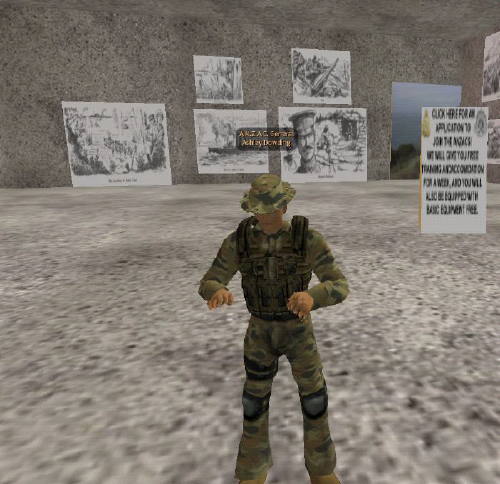1. We profiled the Second Life Cable Network team, who are based in Australia.

2. We interviewed the creator of a very short-live ANZAC build in Second Life.
Tech -- Culture -- Humour
1. We profiled the Second Life Cable Network team, who are based in Australia.

2. We interviewed the creator of a very short-live ANZAC build in Second Life.
UK virtual world consultants, Daden Limited have created an amazing build in Second Life that directly leverages Google Maps content. The visuals say it all:
The NPIRL and Digital Urban blogs have more info as well.
With multiple mirror worlds in development and work like this being done, can you imagine how interesting booking a holiday is going to be in coming years?
Check it out in-world and thanks to Meta Linden for the heads-up.
1. Gamasutra – SGS Panel: Who’s Paying And Why In Virtual Worlds. “At the ongoing Social Gaming Summit in San Francisco, a panel of virtual world execs representing companies like NeoPets, K2, and Nexon got to the heart of why casual virtual worlds were blooming, how developers can make money off of free to play games, and what percentage of players might actually pay. Virtual World News editor and moderator Joey Seiler asked the panel why the casual MMO trend was happening now. Responded K2 marketing VP Patrick Ford, “As a consumer, I have a bookshelf full of $40-60 games that were cracked open once or twice and maybe put back and I didn’t get a good experience from it… but when my son asks me for $5 for a premium package [in an online game], I know it’s money well spent.”
2. Network World – Two online virtual worlds. “In the marketplace of virtual online worlds the 800 pound gorilla is, without doubt, Second Life. But they don’t own the market as much as feature as the poster child. The consequence of that is a small crowd of wannabe’s who have their sights on taking a shot at some kind of market ownership. Given Second Life’s debatable success why would these upstarts care? Simple, because the potential market is enormous. This year (according to eMarketer’s “Kids and Teens: Virtual Worlds Open New Universeâ€) just looking at the pre-teen and teen market some 12 million children and teens will visit virtual worlds — that’s 34% of all Internet users from 3 to 17 years of age — and the figures are projected to keep on growing rising to 53% of all Internet users in that age bracket by 2011 (that’s over 20 million of them!).”
3. Adweek – Movie Studios Expand Into Virtual Web Worlds. “With fewer bodies in movie theaters and consumers migrating en masse to digital formats, Hollywood studios are understandably keen to reach their market in new, hopefully more effective ways. Although virtual worlds have a spotty record so far, some studios clearly see great potential in these environments for both promotion and distribution of their output. In April, Viacom’s Paramount Digital Entertainment signed a partnership agreement with Makena Technologies, making thousands of movie clips from the Paramount movie library available on There.com, an online virtual world. Visitors who purchase the clips can use them to communicate with others by having their avatar “speak” lines from movies while the actual clip plays in a small window. Links allow users to purchase DVDs of the featured movies.”
4. MPOGD.com – ION 2008 – Discussing Entropia Universe with John K. Bates. “magine if you could leave this world behind and start a new life on a foreign planet. MMOs give players the chance to explore new worlds and lands all the time, but rarely will the virtual wealth accumulated in-game ever amount to actual monetary wealth in the real world. Entropia Universe, however, is one game changing that aspect of MMOs, allowing players the opportunity to exchange in-game currency for the real deal. I talked with John K. Bates – Business Development and Strategic Marketing with Mindark/Entropia Universe – at this year’s ION game conference to learn more about the game and how players are turning virtual businesses into real life profits.”
5. Information Week – Second Life Artist Fights Real-Life Deportation. “A Second Life artist who goes by the name “Eshi Otawara” faces real-life deportation due to the so-called “widow’s penalty” in immigration law. The artist, whose real-life name is Irena Morris, is a Croatian immigrant who lives in Florida. Her American husband died suddenly, when they’d been married less than two years, while her application for residency was in progress. According to U.S. immigration law, the application is automatically rejected once the American spouse dies. Morris received formal notification from U.S. immigration authorities last week that her application was terminated, and she’s ready to be deported from the U.S. at any moment.”
6. The Industry Standard – Sun creates virtual worlds for businesses, but graphics lag. “t’s called Project Wonderland and it’s a prototype for a virtual environment where business teams can meet and interact, but the environments so far lack polish and are graphically sparse. The project aims to allow team members using multiple forms of communication to collaborate through video conferencing, call-ins, and online avatars.”
7. The Guardian (UK) – Second Life: Disability charity sets up virtual advice service. “A charity that helps the parents of disabled children contact each other and access services has set up an office in the virtual world of Second Life. The charity, Contact a Family, is using government funding to create the digital office to support its work giving parents information and mutual support.”
8. Web in France Magazine – Executive recruitment in France arrives on Second Life, as the virtual world attracts more real businesses. “Second Life started as 64 acres of virtual real estate in cyberspace. Today, Second Life’s 3D digital world is now the “size†of a small city, where the alter egos of its more than 3 million members, called avatars, interact, socialize at parties, buy and sell virtual goods and run businesses. Members of Second Life, as the name suggests, design a whole parallel universe for themselves where they can have the homes, lifestyles– and especially the careers — that they have always wanted.”
9. CNET – EMI hires ‘Second Life’ co-founder. “Strugging record label EMI Group continues to turn to the technology sector for leadership as it attempts to navigate the Digital Age. The music label hired Cory Ondrejka, one of the founders of Linden Lab’s virtual world, Second Life. Ondrejka was named senior vice president of digital strategy, EMI said in a statement. The hiring comes two months after EMI hired Douglas Merrill, Google’s former chief information officer. Ondrejka left Linden Labs in December. Ondrejka helped design “big parts” of Second Life.”
I missed the announcement of this research a couple of weeks back but thought it was worth passing on the full announcement from Victoria University:
The video gamer stereotype, which says gamers are lonely nerds with low self-esteem, who are addicted to gaming because they are unable to socialise, has been contradicted by research by Victoria University Honours graduate Dan Loton.
In his Psychology Honours thesis, Loton explored the notion of video game addiction, and whether excessive gaming is related to social skills and self-esteem.
He said: “There is a great deal of anecdotal evidence about gaming addiction. Online forums abound with tales of people who can’t get off the computer. But from a clinical point of view, an addiction is a mental illness with very serious consequences. In this context, we need to ask whether gaming is responsible for causing people’s lives to fall apart in the same way we see with gambling, alcohol or drug addiction.”
For the study, Loton developed an online questionnaire that included scales to measure social skills and self-esteem. There was also the Problem Video Game Playing Scale (PVP) used to determine ‘problematic and dependence forming electronic game play’.
He said: “The characteristics that might define a ‘problem gamer’ would be things like an intrusive preoccupation with gaming, where the amount of time they spend playing is affecting their work, sleep, and close relationships; and they want to stop playing games but can’t.”
The gaming community responded well to Loton’s questionnaire and he was able to analyse 621 completed surveys. Around 15 percent of respondents were identified as ‘problem gamers’ who spent more than 50 hours a week playing games.
He said: “We found that those who played Massively Multiplayer Online Role Playing Games (MMORPGs), such as ‘World of Warcraft’, which currently has over 10 million fee-paying monthly subscribers, were more likely to exhibit problematic game play. But, what is important to note is that even ‘problem gamers’ did not exhibit significant signs of poor social skills or low self-esteem. Only one percent of those identified as ‘problem gamers’, appeared to have poor social skills, specifically shyness.”
“We also looked at whether problematic play is impelled by social difficulties, by using a multiple regression analysis to see if high scores on the social skills and self esteem scales could predict problematic playing scores. Our findings strongly suggest that gaming doesn’t cause social problems, and social problems are not driving people to gaming.”
The findings contradict the widely reported statements made last year by the American Medical Association (AMA), which labelled MMORPG gamers as “somewhat marginalized socially, perhaps experiencing high levels of emotional loneliness and/or difficulty with real life social interactions”.
Citing concerns “about the behavioural, health and societal effects of video game overuse” the AMA is likely to consider adding ‘video game addiction’ to the Diagnostic and Statistical Manual of Mental Disorders at its next review in 2012.
Loton said such views may have been prejudiced by outdated stereotypes.
He said: “I think it’s an evolution of social and cultural stereotypes that suggest only nerds and geeks play computer games. The reality is that nowadays everyone is playing video games. A 2007 report by Bond University found that in Australia online gaming is more popular than downloading music and internet shopping.”
Dan Loton is an Ethics Officer with VU’s Office of Research, at Footscray Park Campus.
What are your thoughts? My perception has been that there’s been a steady ‘mainstreaming’ of game play, including virtual worlds – but given my 20+ years of geekiness I’m not best placed to comment 😉
As reported in news.com.au late this week, the Australian Disney website will soon have a direct link to the incredibly popular Club Penguin virtual world for kids.

More Australian staff are expected to be employed, particularly given the future plans for virtual world products based on the Cars and Pixie Hollow franchises.
There’s certainly a momentum building in Australia with an increasing number of people being employed locally – so start polishing those CVs!
1. arco Rosca – Art Lamp
2. Dynamic Shadows In Second Life
3. Out of Africa… in Second Life (tribute to Sidney Pollack)
Metaversum, creator of Twinity are kindly offering fifty Metaverse Journal readers an invitation to join its beta program.
The first fifty people to go to this link will be able to sign up. If you do register, post a comment on your experience with Twinity.
Sporting virtual worlds are few and far between, so the announcement of a soccer MMO is likely to cause some interest. Interzone Futebol (futebol = soccer = football) will initially be released in Portuguese only but international versions are planned not long after.

The feature set touted is:
team-based multiplayer matches, with every character on the pitch (playing field) controlled by a different player, including goalkeepers who, until now, have always been AI-controlled. During the match, players will improve their skills and unlock new skills and moves. Players will also improve their personal rankings and their team’s rankings, earn money through salary or sponsorship, and customize their character at creation, during game play, and by buying virtual items from Interzone’s online store.
There will also be social spaces and a game invitation system. If soccer is your passion and you can speak Portuguese, then you’ll be excited by this. If this MMO delivers an immersive sporting experience, then once the international release occurs you’re likely to hear a lot more about Interzone Futebol. You’ll be able to lay your hands on a virtual black and white ball in the fourth quarter of this year.
So what’s the Australian angle on this? A team of 50 developers worked on Interzone Futebol from Perth WA where it has a design studio located. They say soccer is one of the truly international games and this virtual version is truly an example of that.
That’s the claim by Strategy Analytics, an international strategic and consulting services firm.
Of course, registrations don’t mean too much, it’s the active users that do. That said, if ten percent of those billion end up active it’s still a large market. Add to that the likelihood of greater activity by registration as usability improves and we’re talking large numbers indeed.
Mattel have started to offer a subscription option for its Barbie Girls virtual world. There are literally millions of active users now so Mattel will be hoping a decent percentage of those will beg their parents to fork out US $5.99 per month to be able to customise their avatars more and spend the ‘B Bucks’ their free account has earned.

If you were ever in any doubt about the momentum of virtual worlds, you only need to spend a little time perusing the pre-adult offerings to know where the future lies for online social interaction.
Let’s hear your thoughts – would you pay out for your child to access Barbie Girls VIP? And if not, why not?
A heads-up to GigaOM for the original story.
Copyright © 2024 · Magazine Child Theme on Genesis Framework · WordPress · Log in
Recent Comments